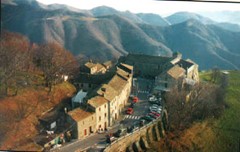From Frassinoro Abbey to the Pilgrims’ Hospice at San Pellegrino in Alpe
From Frassinoro we take the Via Bibulca for an enchanting excursion lasting around 5 hours that crosses unspoilt Apennine countryside. We pass the village of Pietravolta documented as far back as 1222 as one of the places crossed by the Via Bibulca. We continue as far as the Prati di San Geminiano which form a level area close to the Apennine ridge which was already widely used in ancient times as witnessed by finds dating back to Neolithic times. In the XI century, a hospice for wayfarers taking the Via Bibulca stood here, which Countess Matilda had built presumably after the foundation of Frassinoro Abbey in 1071. Nothing remains of the old hospice, but it is possible to admire a small seventeenth-century oratory rebuilt in the 1900s after a disastrous earthquake.
The pilgrims’ hospice of San Pellegrino in Alpe on the Tuscan side of the Apennine ridge dates to the same period and was already documented in 1110, even if tradition would have it that it was founded in the VII century by San Pellegrino himself. It was most likely built to help wayfarers and pilgrims just shortly after Frassinoro Abbey in a pass which is amongst the most out-of-the-way and tricky stretches of this major communication route. Reliquaries of the saint, in the church annexed to the hospice were first mentioned in a papal Brief of 1255, while the first reference to the remains of Saint Bianco comes some thirty years later in a report of a pastoral visit by the Bishop of Lucca in 1559. The gradual establishment of the cult of these reliquaries, which contributed in increasing the hospice’s already burgeoning land and property thanks to generous donations by the faithful, allowed it to survive the general decline in organised assistance in the fourteenth century which affected other similar institutions at the summit of the Apennines near Modena and Reggio Emilia.
Nonetheless the hospice community was reduced to just a few lay brothers, and the buildings suffered considerable damage. The church and the hospice were rebuilt in the middle of the fifteenth century by the rector Leonello de' Nobili from Castiglione in the Garfagnana, the former abbot of Frassinoro. The church, which still houses the bodies of the saints, must have been totally refaced, as witnessed by the fact that very few parts of the original structure can still be identified in the fifteenth century building we see now. Nowadays the San Pellegrino hospice is home to the “Don Luigi Pellegrini” ethnographic museum.
This museum was created thanks to the patient and untiring labour of Don Pellegrini who saw fit to use this demanding project to pay homage to the important rural civilisation of the Tosco-Emilian Apennines. Entrance to the ethnographic museum is through the same vault that leads to the sanctuary. One curiosity concerns the age-old quarrel over the territory of San Pellegrino between the Dukedom of Modena and the Republic of Lucca, which was never properly resolved. Indeed there is still a Modenese “island” in the territory of Lucca, which includes half of the village’s piazza and the left half of the sanctuary, as well as the bodies of the Saints whose heads are in Emilia and their feet in Tuscany. Just a stone’s throw from the hospice is the site nicknamed “Il Giro del Diavolo – The Devil’s Spin” where, according to tradition, the devil in a rage took to slapping San Pellegrino for resisting his temptations, making him spin round three times. The valley below is home to piles of stones created by centuries of wayfarers loading themselves with stones in penitence or for a vow.
